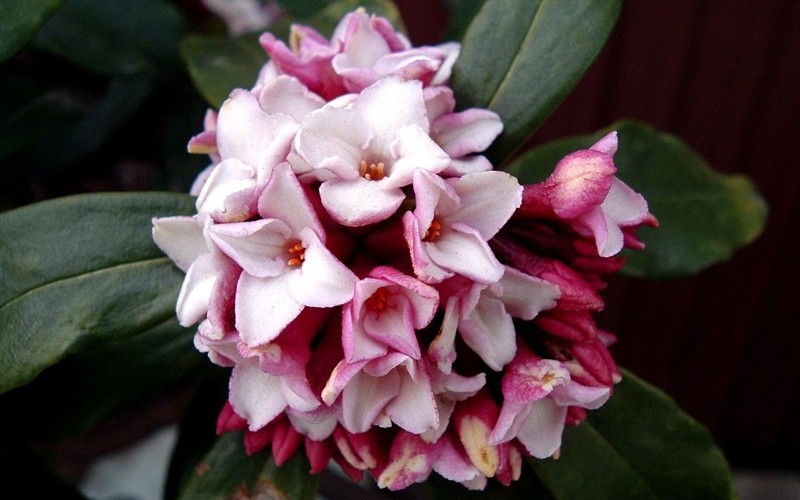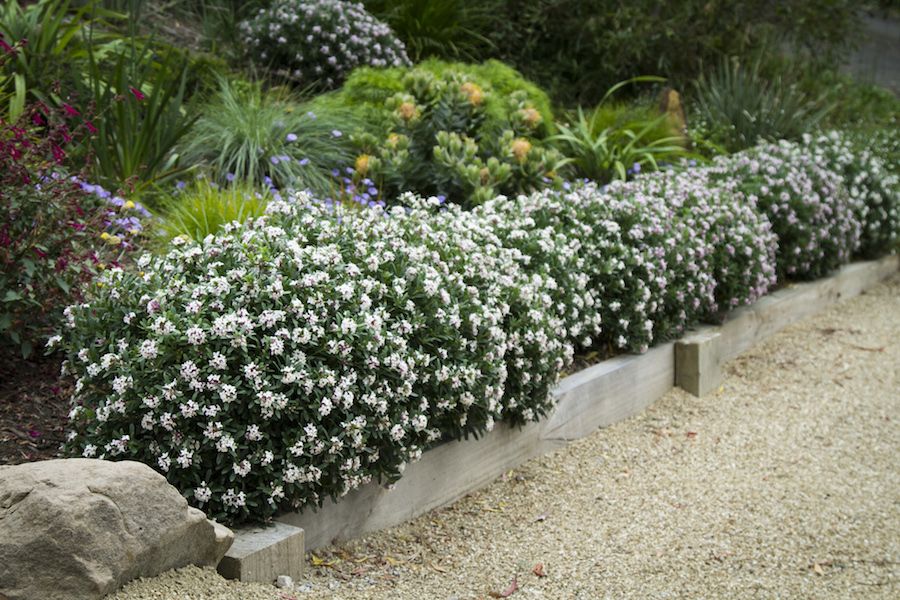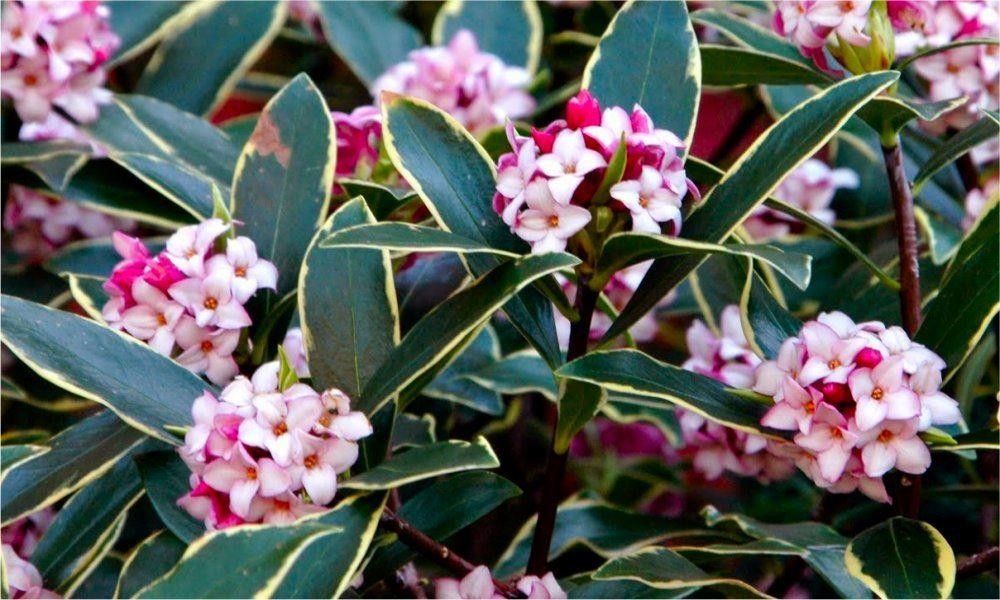
Daphne is a true pure joy. The plants great miracle is that it reigns supreme in the deadening and miserable cold days of winter.
Daphne is blessed with one of the greatest of flower fragrances. Its perfume is truly exquisite. It is so perfectly sweet, it drenches the surrounding air with its scent and when inhaled, is deliciously intoxicating, always uplifting and memorable. You can never, ever, ever, ever, ever, ever have enough plantings of Daphne.
Daphne is a rounded bushy evergreen shrub roughly 1m x 1m in habit and clothed with glossy green leaves. Their star are the clusters of small, waxy, white to wine red flowers borne at the end of the branches from late autumn to early spring. There is an equally beautiful white flowering cultivar ‘Alba’ and a variegated leaved variety. Recently various new varieties have been released, for example D. Eternal Fragrance which has the promise of repeat flowering and more hardiness in hotter conditions. However, they do not carry anywhere near the same rich full fragrance or the crisp rich green foliage of the original D.odora.
In addition, they are true perfection as cut flowers. Place them in a short squat glass or vase and their powerful perfume will gracefully waft, lilt and linger throughout all the four corners of a room. As the Daphne bush progressively get older, they become leggy and untidy, so this winter pruning for cut flowers will greatly benefit the future health, shape and appearance of your plants.

Cultivation
To have success with Daphne there are two essential prerequisites which must be met.
First is the soil. It must be reasonably friable and well-drained, no clay to be seen, coupled with an acidic soil level of ph. 5.5-6. If this is not present or impossible to create, your next bet is to plant them in a pot. A glazed sealed one is best to help retain moisture, not too big and not too small, about 300ml in size would be ideal. It must be potted up with a top-quality potting mix specific for azaleas and camellias.
Very often in autumn and winter, you will see their foliage turn an anaemic sickly yellow and shed leaves from the bottom up. The reason is that the plant is concentrating all its energy into the creation of flowers at the expense of the foliage. To quickly rectify this problem, throw on a few handfuls of Seamungus to strengthen the root system, and a good quality azalea/camellia fertiliser. You can also apply iron chelates or wettable sulphur, but beware, never let it touch the leaves.
Second, is the mandatory protection from summer heat and sun. Daphne’s abhor heat, even in cool to cold climates. If you cannot provide this relief from full afternoon summer sun, and I’m talking from midday on, rethink quickly your positioning. As districts such as the NSW slopes and plains and coastal areas become more hostile with heat, longer hours of shade are required, even to the extent of dappled shade for the entirety of the full day. Planted on the east is optimum positioning. If any of these conditions cannot be met, just don’t even go there, they will quickly curl, shrivel, and perish like old, aged parchment.

Landscaping
To fully benefit from the stunning scent, position them in a garden bed or in pot next to frequently travelled areas, such as stairs, paths, doors and entranceways, outdoor seating and entertaining areas. In most cases, the Daphne is planted on its own as a single specimen. However if you are a bit brave, bold and adventurous and willing to let your imagination fly, there are other fresh landscaping ideas and possibilities in cultivating Daphne in the home garden.
One idea is you could plant a long low clipped hedge of Daphne, reminiscent of a box hedge. I have witnessed such a successful planting, executed beautifully at Heathebrae in the New England region of NSW.
Edging both sides of a long lawn pathway, were two clipped hedges of D. odora, each a good 3m long and 1m high. Behind them were a succession of tightly clipped camellia hedges, three deep in straight rows, each row clipped progressively taller in height, creating a further three tiered, pleached hedge effect. Magnificent. Sadly, this established Daphne hedge died in the great drought of 2020. But this loss does teach us some valuable lessons, for its demise was directly caused by its positioning on the western side of the garden and its exposure to too much harsh, summer afternoon sun, even though it was receiving dappled shade for a few hours from newly planted deciduous trees.
Another idea comes from a previous design of mine. The owners of a long established garden, requested some fresh and original ideas for a particular area of their garden. What I immediately observed was the prolific success of numerous Daphnes. They were as happy as Larry, a good 1.5m in height and width, large rounded rhythmic balls in shape, and rarely if ever tended. Their success undeniably lay in their perfect positioning under the tall and broad canopies of both deciduous trees and old majestic conifers which amply provided the protection from heat, the abundance of autumn leaved mulch and the acidic nature of fallen pine leaves.

In any garden design it is pivotal to build on the present successes and not fight against the site and nature. In addition, In both small and large gardens simple repeat mass planting of the same plant whether it be three, five, seven, nine even up to fifty or more are always aesthetically very effective.
What we agreed was the planting of a large swathe of massed Daphnes, about seven plants wide and five plants in depth. Also included in the design were 5 topiaries of Daphne, staggered throughout to provide vertically, height and visual interest. It was one garden within a larger expansive garden and in the minds of both the client and myself a great success.
Happy gardening and have fun,
Regards Ned McDowell